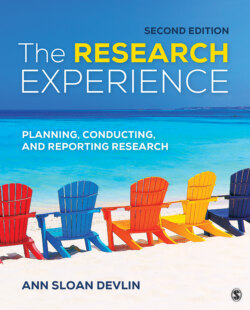Читать книгу The Research Experience - Ann Sloan Devlin - Страница 33
Making a Connection Between a Theory and a Good Research Question
ОглавлениеOften the way research questions are posed limits their scope and potential generalizability; that is, questions are asked in a way that limits them to a particular situation. As an example, you might be interested in the size of artwork displayed in a doctor’s waiting room and the effect of that displayed artwork on patients’ satisfaction with their time spent in the waiting room. Notice that the statement did not say patients’ satisfaction with the entire visit. Here is an important observation. When we think about variables we might manipulate or vary, such as the size of artwork, and the outcomes that might be affected, we need to think about the “distance” or “gap” between these manipulated variables (such as artwork) and the outcome variables (such as satisfaction). Why would we expect the size of artwork in the waiting room to affect satisfaction with the entire visit? Wouldn’t we want to limit our test to a more reasonable relationship—satisfaction with the time spent in the waiting room?
Now when we return to the idea of the size of the artwork, we need to pose this question in a way that avoids a restrictive and narrow focus. If we try to answer this question only for one particular size of art at two different distances, won’t we have to repeat the study with many other sizes and distances? Thus, it would help to see our research question in terms of a larger framework, something like the psychophysics of size, where we could answer the question in terms of the ratio of the size of the art displayed relative to the viewing distance in terms of the effect on satisfaction. For an example of this kind of study, see the work of Jack Nasar and Arthur Stamps (2009) on what are called infill McMansions (“too big” houses constructed in existing smaller-scale neighborhoods). Basing their research on the Weber–Fechner law (proposing a relationship between the magnitude of a physical stimulus and the intensity of people’s responses), Nasar and Stamps showed that what bothers people is not the actual size of the infill house but the relative size of the house (i.e., how the house fits into the neighborhood). Furthermore, in terms of style, large discrepancies in the height of the infill houses relative to neighbors’ houses were more disliked than were large discrepancies in width. This study uses computer-generated houses as stimuli (a very effective means of experimental control) and demonstrates how the order of presentation can be counterbalanced (Chapter 10) to make sure it is the stimuli themselves, and not the order in which they are seen, that influences our responses. In our example of the research on size and distance of art, we would need to test our hypothesis with carefully selected sizes and distances, following the Weber–Fechner law, to reach a conclusion about the ratio of size to distance that produces the most positive outcome. We want to take a specific research question and ask it in a way that has more generalizability (i.e., greater reach)—but not so much that we wouldn’t expect to see any impact (see Chapter 2 for more discussion of the research “gap”).
Weber–Fechner law: When the magnitude of a physical stimulus is increased/decreased by a constant ratio, people’s reactions to it also increase/decrease by equal increments.
